Aussies are being warned to avoid AI search engines after incorrect theories about a four-year-old boy who went missing in the outback spread on social media.
August 'Gus' Lamont was last seen playing in a mound of dirt near his grandparents' homestead on a sheep station 40km south of Yunta, in eastern South Australia, at about 5pm on Saturday, September 27.
He had vanished by the time his grandmother went to call him in, some 30 minutes later.
Police began searching the 60,000ha property shortly after Gus disappeared but found no sign of the little boy.
An extensive land and air search was launched, with hundreds of people scouring the surrounding area in the intervening days, including police, SES volunteers, and members of the Australian Defence Force.
The search also included specialist divers who checked water tanks and dams, infrared cameras, tracking dogs, ATVs, and drones.
However, despite their best efforts, the only trace of Gus was a single footprint found about 500 metres from the homestead - which police have since cast doubt on.
On Friday, just hours after a photo of Gus was released by the family, police made the difficult call to scale back the search from a rescue to recovery.
Four-year-old August 'Gus' Lamont (pictured) went missing on Saturday, September 27
Gus was last seen playing in a mound of dirt near his grandparents' homestead on a sheep station 40km south of Yunta, in eastern South Australia , at about 5pm (pictured)
Despite authorities providing information about the search for Gus, social media users who use Facebook's Meta AI search are being given multiple factual errors.
One Meta AI search summary claimed Gus was 'found alive after a massive search operation in the South Australian outback.'
Another result provided information from South Australia's police website and an online news article, which explained Gus was still missing despite the search effort.
A spokesperson for South Australia Police urged anyone looking for information about missing persons, emergency events, or investigations to visit official websites or reliable social media pages.
'Police urge caution when using artificial intelligence in internet searches and recommend cross-referencing the information with trusted sources,' they said.
Another vile conspiracy falsely claimed Gus' loved ones are responsible for foul play.
'The family would not have harmed this child even if the world was about to come to an end, which it really has now for them,' family friend Fleur Tiver said.
'There is no way they've harmed this child. I think it's unfortunate people are speculating, because things like this pain the family, but I do understand that when there are so many unanswered questions, people will naturally try to fill in the gaps, even if their theories are implausible and impractical.'
Experts are warning social media users to avoid using AI search engines for information about missing persons, as the results provided are sometimes factually incorrect (pictured, search result claiming Gus was found)
Ms Tiver said she knew the Lamont family 'well' and described them as 'kind', 'gentle', 'reliable', 'trustworthy', and 'truthful'.
'They embody everything about humans that can be good,' she said.
Expert in missing persons, Dr Sarah Wayland, explained technology was adding a 'new dimension' to information about missing persons.
Dr Wayland added developing technology, such as AI search engines, was creating an additional layer of trauma of the loved ones and families of those missing.
'It's adding a whole new dimension, on top of [media] stories, where that information is not accurate and it's based on not just the media reporting, but also the harvesting of social media comments,' Dr Wayland told The ABC.
Dr Wayland said AI generated content was sometimes easily believed as factual and cautioned users to take a 'trauma-informed approach' before sharing information online.
'We need to question where is this information coming from and is this the most accurate information at this stage,' Dr Wayland said.
'If we can't verify that, then maybe pause, rather than commenting.'
On Friday, South Australian Assistant Police Commissioner Ian Parrott made the difficult call to scale back the search for Gus, with the sad admission that it's unlikely he will be found alive.
'While we've all been hoping for a miracle, that miracle was not eventuated,' Commissioner Parrott said.
'And in the last 48 hours, despite the professional advice it being unlikely that Gus would have survived, we have maintained and in fact increased the effort to try and locate him and bring him back to his family.
'We're confident that we've done absolutely everything we can to locate Gus within the search area.
'But despite our best efforts, we have not been able to locate him, and unfortunately, we are now having to scale back this search for Gus.
Hundreds of people scoured the surrounding area in the intervening days including police, SES volunteers and members of the Australian Defence Force, in the search for Gus
Police searched the 60,000ha property shortly after Gus disappeared but found no sign of the little boy (pictured, volunteers at the property)
Despite their best efforts, the only trace of Gus was a single footprint found about 500 metres from the homestead (pictured)- which police have since cast doubt on
'We won't stop, we will continue to investigate and follow any lines of inquiry that we currently have.'
The tough call was based on scientific and professional advice on how long a four-year-old could survive alone in remote terrain in freezing overnight temperatures in the clothing Gus was last seen wearing.
Gus was last seen wearing a grey broad-brimmed hat, a blue long-sleeved shirt with a Minion picture from Despicable Me on the front, light grey pants, and boots.
Police believe that Gus wandered off and was not taken, as the only people who travel on the nearby road are station owners.
'Everything that we have found to date, every piece of information and evidence that we have explored to date, indicates that, as best as we know, Gus has wandered off from this property and we have not been able to locate him,' Parrott said.
Locals believe the four-year-old may have fallen into a disused and unmarked mine.
The state is dotted with mines and wells from more than a century ago. They were used as water sources for livestock and those hunting gold, with many being invisible to the naked eye.
[SRC] https://www.dailymail.co.uk/news/article-15168199/gus-lamont-australia-theories.html
 Visit the website
Visit the website







